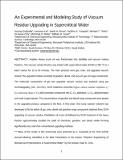| dc.contributor.author | Tompsett, Geoffrey A. | |
| dc.contributor.author | Timko, Michael T. | |
| dc.contributor.author | Choi, Ki-Hyouk | |
| dc.contributor.author | Alabsi, Mohnnad H. | |
| dc.contributor.author | Gudiyella, Soumya | |
| dc.contributor.author | Lai, Lawrence Tin Chi | |
| dc.contributor.author | Borne, Isaiah H. | |
| dc.contributor.author | Green Jr, William H | |
| dc.date.accessioned | 2018-02-22T15:53:36Z | |
| dc.date.available | 2018-02-22T15:53:36Z | |
| dc.date.issued | 2018-02 | |
| dc.identifier.issn | 0001-1541 | |
| dc.identifier.issn | 1547-5905 | |
| dc.identifier.uri | http://hdl.handle.net/1721.1/113861 | |
| dc.description.abstract | Arabian Heavy crude oil was fractionated into distillate and vacuum residue fractions. The vacuum residue fraction was treated with supercritical water (SCW) at 450°C in a batch reactor for 15 to 90 minutes. The main products were gas, coke, and upgraded vacuum residue; the upgraded residue consisted of gasoline, diesel, and vacuum gas oil range components. The molecular composition of gas and upgraded vacuum residue was analyzed using gas chromatography (GC, GC×GC). SCW treatment converted higher carbon number aliphatics (≥ C[subscript 21]) and long chain (≥ C[subscript 5]) alkyl aromatic compounds into C[subscript 1]-C[subscript 20] aliphatics, C[subscript 1]-C[subscript 10] alkylaromatics and multi-ringed species. The concentrations of gasoline and diesel range compounds were greater in the upgraded product, compared to the feed. A first-order, five lump reaction network was developed to fit the yields of gas, coke, diesel and gasoline range components obtained from SCW upgrading of vacuum residue. Distillation of crude oil followed by SCW treatment of the heavy fraction approximately doubled the yield of chemicals, gasoline, and diesel, while forming significantly less coke than conventional upgrading methods. | en_US |
| dc.language.iso | en_US | |
| dc.publisher | Wiley Blackwell | en_US |
| dc.relation.isversionof | http://dx.doi.org/10.1002/aic.16131 | en_US |
| dc.rights | Creative Commons Attribution-Noncommercial-Share Alike | en_US |
| dc.rights.uri | http://creativecommons.org/licenses/by-nc-sa/4.0/ | en_US |
| dc.source | Prof. Green | en_US |
| dc.title | An Experimental and Modeling Study of Vacuum Residue Upgrading in Supercritical Water | en_US |
| dc.type | Article | en_US |
| dc.identifier.citation | Gudiyella, Soumya, et al. “An Experimental and Modeling Study of Vacuum Residue Upgrading in Supercritical Water.” AIChE Journal, Feb. 2018. | en_US |
| dc.contributor.department | Massachusetts Institute of Technology. Department of Chemical Engineering | en_US |
| dc.contributor.approver | Green, William H. | en_US |
| dc.contributor.mitauthor | Gudiyella, Soumya | |
| dc.contributor.mitauthor | Lai, Lawrence Tin Chi | |
| dc.contributor.mitauthor | Borne, Isaiah H. | |
| dc.contributor.mitauthor | Green Jr, William H | |
| dc.relation.journal | AIChE Journal | en_US |
| dc.eprint.version | Author's final manuscript | en_US |
| dc.type.uri | http://purl.org/eprint/type/JournalArticle | en_US |
| eprint.status | http://purl.org/eprint/status/PeerReviewed | en_US |
| dspace.orderedauthors | Gudiyella, Soumya; Lai, Lawrence; Borne, Isaiah H.; Tompsett, Geoffrey A.; Timko, Michael T.; Choi, Ki-Hyouk; Alabsi, Mohnnad H.; Green, William H. | en_US |
| dspace.embargo.terms | N | en_US |
| dc.identifier.orcid | https://orcid.org/0000-0001-6439-2400 | |
| dc.identifier.orcid | https://orcid.org/0000-0001-8866-7739 | |
| mit.license | OPEN_ACCESS_POLICY | en_US |
